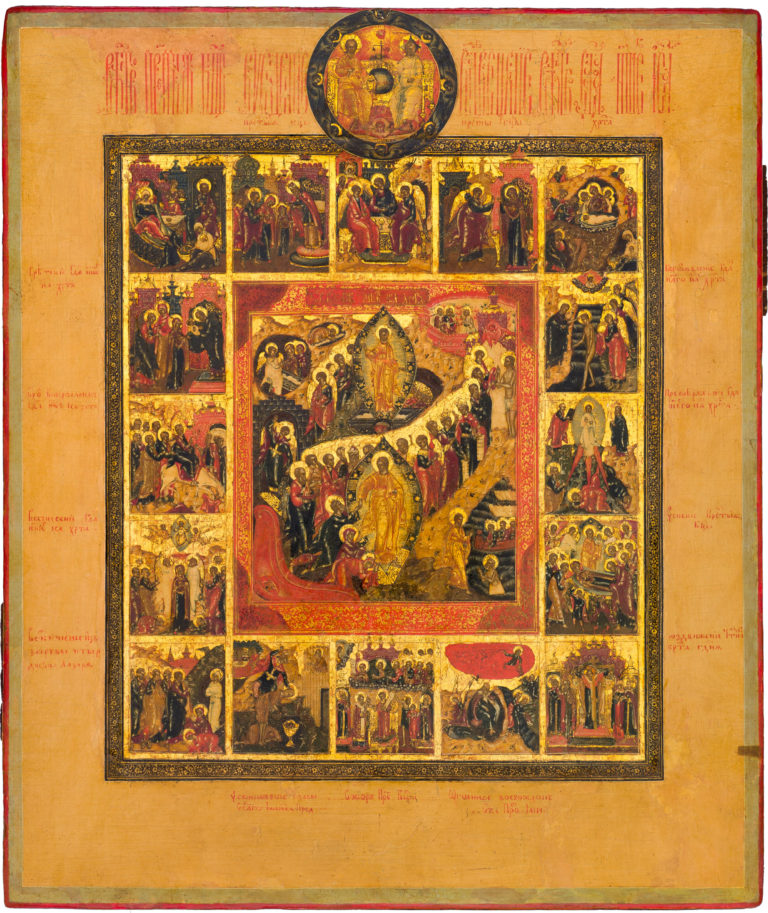The Resurrection—the Descent into Hell, with the Holy Trinity and the Church Feasts in 16 Border Scenes
Antique Russian icon. Last quarter – end of the 18th century. Palekh.
Size: 36 х 30 х 2,5 см
Wood (one whole panel), two incut profiled support boards, a shallow incut centerpiece, underlying layer of canvas is not visible, gesso, tempera, gold.
The author’s paintwork is in an overall good state with only several small fallouts of the paint in places, chafing on the sides, several restoration tonings on the borders of the religious icon panel.
Contact us

The Resurrection—the Descent into Hell, with the Holy Trinity and the Church Feasts in 16 Border Scenes
Diagram of the border scenes:
- The Nativity of the Mother of God;
- The Entrance of the Mother of God into the Temple;
- The Old Testament Trinity;
- The Annunciation;
- The Nativity of Christ;
- Candlemas (The Meeting of Christ in the Temple);
- The Theophany (The Baptism of Christ);
- The Entrance into Jerusalem;
- The Transfiguration;
- The Ascension;
- The Dormition of the Mother of God;
- The Raising of Lazarus;
- The Beheading of John the Baptist;
- The Pokrov (Feast of the Protective veil of the Mother of God);
- The Fiery Ascent of the Prophet Elias;
- The Elevation of the Holy Cross;
- The Holy Trinity (Enthronement).
The art of the small village of Palekh (in the Vladimir region) is rightly considered one of the most significant phenomena of the Russian Imperial period. Already in the middle of the 18th century, Palekh was a large and independent religious icon art center. The given antique Russian icon of the Resurrection – the Harrowing of Hades with Church Feasts is one of the first-class examples of local Eastern Orthodox iconography and also one of the signature pieces of early period Palekh religious icon art.
By the end of the 18th century, Palekh’s artists had formed several important iconographic schemes of Church Feasts, which won immense popularity in the following years. One of the favorite variations was the “Resurrection – the Harrowing of Hades” scene surrounded by Church Feasts. Such religious icon paintings reflected the main events of the liturgical year were known among artists as “polnitsy” (Russian for “full-cycle” icons). The centerpiece of these hand-painted icons was traditionally occupied by the detailed version of the Resurrection scene. The Rising from the Tomb and the Harrowing of Hades were portrayed along a single axis, embraced by the diagonal processional line of the Pious marching from the Gates of Hell to the Kingdom of Heaven. This scene was surrounded by other events that either predated or followed the Resurrection. The earlier religious icons have a number of such supplementary scenes – besides “The Revelation of the Angel to the Myrrh-bearing women,” “Saint Peter at the Empty Tomb,” “The Revelation of Christ to the Apostles on the Sea of Galilee,” they also include the depiction of the Heavenly Kingdom, where Rach the Good Thief is shown conversing with Elias and Enoch. The surrounding frame is highly traditional and includes 16 border scenes. It begins with the Nativity of the Mother of God, which opens the Feast cycle of the liturgical year, and ends with the Elevation of the Holy Cross. The inclusion of the Old Testament Trinity into the center of the topmost tier, which breaks the liturgical and historical chronology, is a typical and symbolic element of Palekh religious icon art. Over the top tier, we also see the New Testament Trinity (The Enthronement) – another characteristic element of complex Palekh hand-painted icons, the border scenes of which were usually established by the commissioner.
The artistic execution of the given antique Russian icon, noted for its highly individual and expressive manner, aesthetic and emotional painting (with the elongated figures and delicate, round heads), was borrowed from the Stroganov tradition. The fact that this religious icon was painted at quite an early stage of Palekh’s development is clearly confirmed by the lively manner of the artist, not prone to standardization and copying. The iconographer intuitively created the light shapes, the uplifting rhythm of the feather-like mountains, and the transparency of the many-colored layers. The artist’s skill to “miniature” painting is revealed in the extensive and exquisite ornamentation covering the architectural motifs, the interior of the chambers, the numerous fabrics and draperies, as well as the frames of the centerpiece and border scenes. Each religious icon border scene is no more than 3 cm in height, yet is filled with many details. For example, the small scene of the Beheading of John the Baptist includes the depiction of King Herod feasting at his table, while the Old Testament is shown in the “Hospitality of Abraham” version, with Abraham and Sarah present. This small and wonderfully hand-painted icon, made for home prayer, is a great testament to the glory of Palekh’s artists.